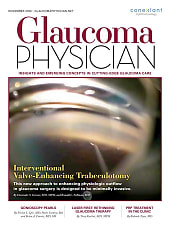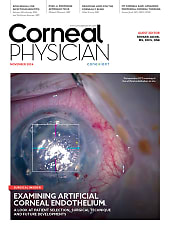A 61-year-old female presented with a history of interstitial cystitis (IC) complaining of blurry vision and dyschromatopsia. She had taken 400 mg pentosan polysulfate sodium (PPS) from 2012 to 2018, but stopped when she discovered the medication could affect vision.
Although her acuity was 20/30 OD and 20/40 OS, she had diffuse, pigmentary changes in a pisciform-type morphology. The RPE was disorganized and fundus autofluorescence revealed hyper-autofluorescent lesions in the macula, sparing the peripapillary retina (Figure 1). Her OCT showed an attenuated outer segment and subretinal deposits. There were also some central disturbances of her visual fields. She was told by other eyecare providers that she may have macular degeneration.

DIFFERENTIALS
Poppers are alkyl nitrates that induce smooth muscle relaxation and facilitate anal sexual intercourse. They can cause a central scotoma, with disruption of the subfoveal IS/OS junction seen on OCT.
Didanosine is a component of highly active antiretroviral therapy used to manage AIDS and causes equatorial pigmentary retinal atrophy abnormalities, but is no longer in widespread use.
Thioridazine (Mellaril) is an anti-psychotic of the phenothiazine family. It many side effects, including widespread lipophilic interaction with the RPE, causing pigmentary degeneration.
Deferoxamine is a commonly used chelating agent for treating transfusional hemochromatosis. Unfortunately, it causes confluent RPE changes with hyperreflective deposits and thickening of Bruch’s and Haller’s layers within the choroid.
Regarding cancer therapies, mitogen-activated protein kinase (MEK) inhibitors, which are a new class of chemotherapy for metastatic melanoma, may cause multifocal, subretinal fluid loculations when it is in current use and can cause diffuse pigmentary sequelae when it is discontinued.
Finally, denileukin diftitox is a fusion protein of portions of the diptheroid toxin and IL-2. It targets the IL-2 receptor on malignant cells and induces apoptosis. The first reported case of pigmentary abnormalities of the retina was in 2018.
PPS TOXICITY
Pentosan polysulfate sodium toxicity was first approved in 1996 for IC, otherwise known as bladder pain syndrome, which is thought to occur due to abnormalities in uroepithelial glycosaminoglycans, irregularities in uromodulin (Tamm-Horsfall protein), and local inflammatory cascades. In addition to pelvic pain, patients report urinary urgency, frequency, and nocturia. Interestingly, a randomized controlled trial by Nickel in 2015 showed that there was no treatment effect with PPS for IC as compared to placebo.1
A potential link to pigmentary retinopathy was first described by Pearce et al. in 2018.2 Their patients had an average duration of use of 15.5 years, and experienced metamorphopsia, scotoma, prolonged dark adaptation, and decreased contrast sensitivity. Bilateral color fundus photographs showed macular pigmentary changes, as well as vitelliform deposits and patchy paracentral RPE atrophy. Near infrared reflectance images showed irregular reflectance with prominent hyperreflectance, colocolizing with the hyper pigmented foci noted on the fundus exam (Figure 1). All patients underwent extensive genome analysis and no known mutations were discovered to be associated with any known inherited retinal degeneration.
A year later, the group collaborated with other academic institutions and redemonstrated the findings.1 Further calculations led authors to conclude that the odds ratio of developing PPS-related maculopathy to be 11:2 at the duration described.3 Some have questioned this theory. A large data review found that the incidence of any pigmentary retinopathy decreased over time in those using PPS, compared with statistically insignificant but greater incidence in patients with IC not taking PPS. However, only 29% of those in this study underwent physical exam, it was not known when this exam occurred, and the longest duration of use was 5 years.4 In fact, the mean duration of use in this group of patients was 258 days, far less than the mean of 15.5 years as described by Pearce.
PPS may cause a pigmentary macular disorder when used long-term for IC. Our urinary colleagues even suggest that it may not be effective for the condition. NRP
REFERENCES
- Nickel JC, Herschorn S, et al. Pentosan polysulfate sodium for treatment of interstitial cystitis/bladder pain syndrome: insights from a randomized, double-blind, placebo-controlled study. J Urol. 2015;193(3):857-862.
- Pearce WA, Chen R, Jain N. Pigmentary maculopathy associated with chronic exposure to pentosan polysulfate sodium. Ophthalmology. 2018;125(11):1793-1802.
- Hanif AM, Shah R, et al. Strength of association between pentosan polysulfate and a novel maculopathy. Ophthalmology. 2019;126(10):1464-1466.
- Ludwig CA, Vail D, et al. Pentosan polysulfate sodium exposure and drug-Induced maculopathy in commercially insured patients in the United States. Ophthalmology. 2020;127(4):535-543.








